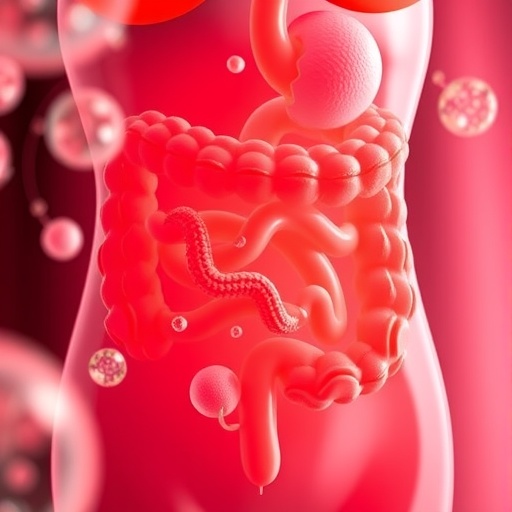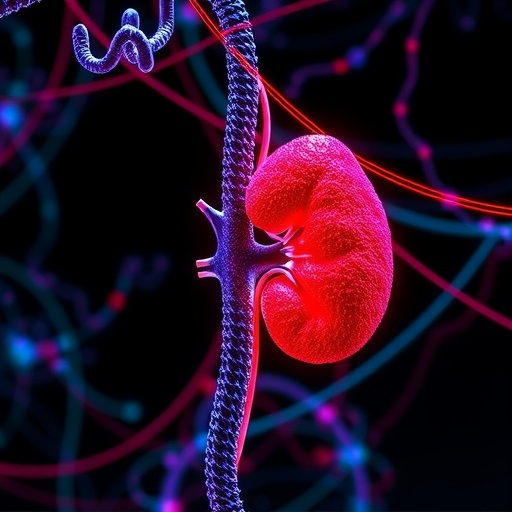
In recent years, the pervasive infiltration of micro- and nanoplastics into the environment has raised alarming concerns regarding their potential impacts on human health. A groundbreaking study published in Nature Communications now sheds light on the intricate ways polystyrene nanoplastics interfere with the delicate balance of our gut microbiome, unveiling a previously unrecognized mechanism involving extracellular vesicle (EV)-mediated microRNAs. This discovery takes us into the microscopic battleground where foreign particles and host biology clash, with profound implications for understanding inflammatory diseases and gut health in the age of rampant plastic pollution.
The intestinal microenvironment is a multifaceted ecosystem where trillions of bacteria coexist symbiotically with the human host, influencing immune responses, nutrient absorption, and even mental health. Disruptions in this finely tuned system have been linked to a plethora of diseases ranging from inflammatory bowel disease to metabolic syndrome. Hsu, Chen, Chiang, and colleagues have taken a crucial step forward by demonstrating how polystyrene nanoplastics, a common constituent of environmental pollutants, perturb this ecosystem through subtle yet insidious molecular dialogues.
At the core of their research lies the discovery that polystyrene nanoplastics do not simply act as inert particles invading the gut milieu. Instead, these nanoplastics influence the communication between bacteria and their host by modulating the profiles of microRNAs, small non-coding RNA molecules that regulate gene expression post-transcriptionally. The key conveyors of these effects are extracellular vesicles, nanoscale lipid bilayer-enclosed particles secreted by bacteria, which carry specific microRNAs capable of crossing biological barriers and reprogramming host cells.
.adsslot_nUHsfoMmL9{width:728px !important;height:90px !important;}
@media(max-width:1199px){ .adsslot_nUHsfoMmL9{width:468px !important;height:60px !important;}
}
@media(max-width:767px){ .adsslot_nUHsfoMmL9{width:320px !important;height:50px !important;}
}
ADVERTISEMENT
This nuanced bacterial-host crosstalk, hijacked by the nanoplastics, manifests as an altered microenvironment that compromises the intestinal barrier, impairs immune responses, and reshapes microbial community structures. By exposing laboratory models to polystyrene nanoplastics, the researchers meticulously mapped the ensuing molecular alterations, showing that these pollutants effectively recalibrate the composition of bacterial EV-delivered microRNAs. This recalibration in turn influences host gene expression profiles critical for maintaining intestinal homeostasis.
Delving into the mechanistic underpinnings, the study reveals that the nanoplastics perturb bacterial membrane integrity, subtly altering the biogenesis of extracellular vesicles and their cargo selection. These vesicles, laden with specific microRNAs, traverse the intestinal mucosa and interact with epithelial cells and immune populations, modulating pathways involved in inflammation, cellular stress responses, and barrier function. The altered microRNA signatures found within EVs serve as functional messengers that perpetuate the disruption of host-bacteria harmony.
The implications of these findings are manifold. On a cellular level, this research elucidates how environmental contaminants can exert influence far beyond physical presence, leveraging biological messaging systems inherent to our microbiota to amplify their pathogenic potential. It redefines the paradigm of toxicity by highlighting epigenetic and transcriptomic modulation mediated by extracellular vesicles as a key driver of nanoplastic-induced pathology.
Moreover, the study’s findings raise alarm bells regarding the long-term consequences of chronic exposure to nanoplastics, particularly polystyrene, which is omnipresent in everyday plastic consumer products. By distinctly showing how nanoplastics disrupt microenvironment homeostasis via microRNA pathways, the research underscores potential links to clinically relevant conditions such as gastrointestinal inflammation, immune dysregulation, and increased susceptibility to infections and chronic diseases.
From a methodological standpoint, the authors employ cutting-edge techniques combining RNA sequencing of extracellular vesicle cargo, advanced microscopy to track nanoplastic-bacteria interactions, and in vivo models that faithfully recapitulate human gut physiology. The high resolution of microRNA profiling allows for pinpointing specific regulatory molecules responsible for triggering downstream host responses, offering unprecedented insights into molecular toxicology of nanoplastics.
Notably, this research also opens up new avenues for therapeutic intervention. By targeting specific microRNAs delivered via bacterial EVs or modulating EV biogenesis pathways, future treatments could potentially restore intestinal homeostasis disrupted by environmental pollutants. It paves the way for a new class of molecular strategies focused on microbiota-host communication rather than solely combating the physical or chemical presence of pollutants.
Furthermore, this study invites a reexamination of current environmental and public health policies addressing plastic pollution. The subtle yet invasive mode of action demonstrated here challenges traditional assessments of pollutant risk, which often overlook epigenetic and microbiome-mediated impacts. Incorporating these novel molecular endpoints into regulatory frameworks might be crucial to better safeguard human health against the burgeoning nanoplastic burden.
The research also highlights the importance of interdisciplinary approaches merging microbiology, molecular biology, toxicology, and environmental sciences. Understanding how nanoplastics influence gut microbial communication networks requires insights drawn from diverse fields, reiterating the complexity of the problem and the urgency to tackle it holistically.
Finally, beyond the immediate biological insights, this study compels scientists and the public alike to reconsider the unseen ways in which modern human activity—through widespread plastic usage—alters fundamental biological processes. It alerts us to the hidden molecular consequences embedded within everyday exposure scenarios, inspiring renewed efforts to reduce plastic contamination at its source.
As emerging data continues to unravel the intricate connections between environment, microbiome, and human health, this landmark study by Hsu et al. stands as a critical milestone. It not only broadens our understanding of microplastic toxicity but also highlights the pivotal role of extracellular vesicle-mediated microRNAs as central players in the dialogue between microbial communities and their human host. In an era where pollution has become a microscopic threat, these findings are a wake-up call, signaling the need for urgent scientific, medical, and environmental action to mitigate the silent but profound impacts of nanoplastics on our bodies.
Subject of Research: The impact of polystyrene nanoplastics on the intestinal microenvironment, focusing on how these nanoplastics disrupt bacteria-host interactions by altering microRNAs delivered via bacterial extracellular vesicles.
Article Title: Polystyrene nanoplastics disrupt the intestinal microenvironment by altering bacteria-host interactions through extracellular vesicle-delivered microRNAs.
Article References:
Hsu, WH., Chen, YZ., Chiang, YT. et al. Polystyrene nanoplastics disrupt the intestinal microenvironment by altering bacteria-host interactions through extracellular vesicle-delivered microRNAs. Nat Commun 16, 5026 (2025). https://doi.org/10.1038/s41467-025-59884-y
Image Credits: AI Generated
Tags: environmental pollution and human healthextracellular vesicle microRNAsgut microbiome disruptionimmune responses and gut bacteriainflammatory diseases and gut microbiomemetabolic syndrome and gut healthmolecular mechanisms of gut bacteriananoplastics impact on gut healthplastic pollution and microbiotapolystyrene nanoplastics effectsresearch on nanoplastics and healthsymbiotic relationships in gut ecosystem





